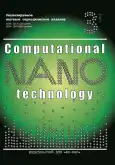Метод обнаружения признаков угроз информационной безопасности объектов критической информационной инфраструктуры на основе цифровых двойников
- Авторы: Митяков Е.С.1
-
Учреждения:
- МИРЭА – Российский технологический университет
- Выпуск: Том 12, № 3 (2025)
- Страницы: 115-122
- Раздел: МЕТОДЫ И СИСТЕМЫ ЗАЩИТЫ ИНФОРМАЦИИ, ИНФОРМАЦИОННАЯ БЕЗОПАСНОСТЬ
- URL: https://bakhtiniada.ru/2313-223X/article/view/350191
- DOI: https://doi.org/10.33693/2313-223X-2025-12-3-115-122
- EDN: https://elibrary.ru/BGUXHV
- ID: 350191
Цитировать
Аннотация
В статье представлен метод обнаружения признаков угроз информационной безопасности (ИБ) объектов критической информационной инфраструктуры (КИИ) на основе цифрового двойника (ЦД) с адаптивным механизмом. Рассматриваются ограничения традиционных подходов ИБ в условиях дефицита данных о реальных атаках, сложности тестирования на действующих объектах КИИ и трудностей выявления целенаправленных, маскирующихся угроз. Предложен двухконтурный метод обнаружения признаков угроз ИБ (контур ЦД и контур объекта КИИ), интегрированный с трехуровневым адаптационным механизмом (оперативный, тактический, стратегический режимы). Метод включает этапы генерации синтетических данных, обучения/тестирования моделей в ЦД, детектирования/классификации на объекте КИИ, а также определяет критерии (триггеры) инициирования адаптации. Ключевые преимущества метода: возможность безопасной генерации сценариев угроз и обучения в виртуальной среде ЦД, автоматизированное поддержание актуальности моделей обнаружения признаков угроз ИБ. Результаты апробации на синтетической модели АСУ ТП энергосистемы демонстрируют улучшение метрик качества после адаптации.
Полный текст
Открыть статью на сайте журналаОб авторах
Евгений Сергеевич Митяков
МИРЭА – Российский технологический университет
Автор, ответственный за переписку.
Email: mityakov@mirea.ru
ORCID iD: 0000-0001-6579-0988
SPIN-код: 5691-8947
доктор экономических наук, профессор, заведующий, кафедра КБ-9
Россия, г. МоскваСписок литературы
- Bozdal M. Security through digital twin-based intrusion detection: A SWaT dataset analysis // 16th International Conference on Information Security and Cryptology (ISCTürkiye). 2023. Pp. 1–6. doi: 10.1109/ISCTrkiye61151.2023.10336137.
- De Hoz Diego J., Temperekidis A., Katsaros P., Konstantinou C. An IoT digital twin for cyber-security defence based on runtime verification // LNCS. 2022. Pp. 556–574. doi: 10.1007/978-3-031-19849-6_31.
- Krishnaveni S., Chen T., Sathiyanarayanan M., Amutha B. CyberDefender: An integrated intelligent defense framework for digital-twin-based industrial cyber-physical systems // Cluster Computing. 2024. Vol. 27. Pp. 7273–7306. doi: 10.1007/s10586-024-04320-x.
- Lv H.B., Chen D.L., Cao B. et al. Secure deep learning in defense in deep-learning-as-a-service computing systems in digital twins // IEEE Transactions on Computers. 2024. Vol. 73. No. 3. Pp. 656–668. doi: 10.1109/TC.2021.3077687.
- Ma J., Guo Y., Fang Ch., Zhang Qi. Digital-twin-based cps anomaly diagnosis and security defense countermeasure recommendation // IEEE Internet of Things Journal. 2024. Vol. 11. Pp. 18726–18738. doi: 10.1109/JIOT.2024.3366904.
- Masi M., Sellitto G., Aranha H., Pavleska T. Securing critical infrastructures with a cybersecurity digital twin // Software and Systems Modeling. 2023. Vol. 22. Pp. 689–707. doi: 10.1007/s10270-022-01075-0.
- Patel T., Jadav N., Rathod T. et al. AI-based secure intrusion detection framework for digital twin-enabled critical infrastructure // 14th International Conference on Information and Knowledge Technology (IKT). 2023. Pp. 24–29. doi: 10.1109/IKT62039.2023.10433057.
- Salim M., Camacho D., Park J. Digital Twin and federated learning enabled cyberthreat detection system for IoT networks // Future Generation Computer Systems. 2024. Vol. 161. Pp. 701–713. doi: 10.1016/j.future.2024.07.017.
- Sousa B., Arieiro M., Pereira V. et al. ELEGANT: Security of critical infrastructures with digital twins // IEEE Access. 2021. Vol. 9. Pp. 107574–107588. doi: 10.1109/ACCESS.2021.3100708.
- Баянова Ю.А. Критическая информационная инфраструктура как объект обеспечения безопасности // Инновационная наука. 2021. № 10-2. С. 63–65.
- Кочергин С.В., Артемова С.В., Бакаев А.А. и др. Обнаружение аномалий в энергосистемах: применение модели Isolation Forest для выявления киберугроз // Безопасность информационных технологий. 2025. Т. 32. № 1. С. 112–121. doi: 10.26583/bit.2025.1.07.
- Кочергин С.В., Артемова С.В., Бакаев А.А. и др. Повышение безопасности смарт-сетей: спектральный и фрактальный анализ как инструменты выявления кибератак // Russian Technological Journal. 2025. Т. 13. № 1. С. 7–15. doi: 10.32362/2500-316X-2025-13-1-7-15.
- Митяков Е.С. Проблемы использования цифровых двойников в задачах обеспечения информационной безопасности объектов критической информационной инфраструктуры // Информационные технологии и телекоммуникации. 2023. Т. 11. № 4. С. 36–47. doi: 10.31854/2307-1303-2023-11-4-36-47.
- Митяков Е.С. Цифровые двойники и безопасность критической информационной инфраструктуры: правовые и технологические аспекты // Национальная безопасность и стратегическое планирование. 2024. № 4 (48). С. 29–34. doi: 10.37468/2307-1400-2024-4-29-34.
- Саух И.А. Объекты критической информационной инфраструктуры в условиях возникновения информационных атак // Инновации. Наука. Образование. 2022. № 49. С. 1302–1306.











